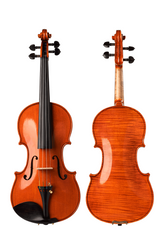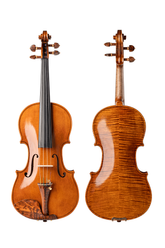Do you know common types of violins?
The shape of the violin not only affects the appearance of the violin but also has a direct relationship with the quality of the sound quality.
5 common types of violins
There are 5 common types of violins, follow us to learn about them.

1:G.P. Maggini type: The most noticeable feature is that the headstock is four-layered, and the trim on the piano board is double-sided. Sometimes the back panel trim is embedded with various patterns, and the color is primarily light yellow or dark brown. This kind of violin has a large size, a long body, a wider board, and a lower side board. The top board is slightly thicker than the backboard. The curvature of the surface and the backboard surface is small and relatively flat. The curvature of the sub-top board starts from the near edge. Yes, this expands the vibration area and enhances the volume, so when playing, it has a deep and loud pronunciation, a good transmission effect, and a unique sound quality. The disadvantage is that the sound of the violin is noisy, and not clean enough, the sound hole is straight and long, the headstock is small, and it is not commensurate with the wide body, so the appearance is not very beautiful.

2:Andrea Amati type: This kind of violin has a narrow body in the middle, a thicker top and long corners in the middle of the top, a high curvature in the middle of the top and abruptly sloping down to the edge of the board. The edge of the board is also easy to vibrate. The headstock of this kind of violin is larger, the sound hole is curved and short, and the sound quality is sweeter than that of the Maggini type, especially since the sound of the G and D strings is more beautiful.
The disadvantage is that the vibration area is small, the pronunciation is not loud enough, and the transmission effect is not good, so it is only suitable for use in small concert halls.

3:Stradivarius type: The standard violin shape is that the upper part of the case is relatively narrow, the lower part is relatively wide, and the middle part is slightly curved, which not only matches the outline but also has beautiful lines. The violin board is wide and flat, with a very slight curvature. It is thick in the middle and gradually expands to the surrounding area. The S-style violin has a strong and powerful pronunciation, a loud sound, a beautiful timbre, and an excellent long-distance transmission effect. Its sound is more powerful than the Maggini type and more beautiful than the Amati type. People often use words such as roundness, subtlety, richness, and purity to describe their timbre.

4:Guarneri type: The characteristics of this type of violin are that the radian of the board is not large and relatively flat, the thickness difference between the middle of the front panel and the surrounding area is small, and the upper and middle parts of the box are wider than the zither, the middle part is not deeply curved, and the horns are not as protruding like that. the lower part of the body is narrow, the sound hole is longer and the style is unique, the headstock is larger and the style is majestic. Because Guarneri only pays attention to the sound effect of the violin, the appearance of the violin is not as delicate and beautiful as the violin. However, the vibration of the board is strong and powerful, and the sound is deep and loud.

5:Jacob Stainer type: The sound quality of Jacob's violin stems from the special structure and technology of the violin. His violin is slightly shorter and narrower than the Italian violin, and the wood used is carefully selected. The specific features are as follows:
- Broad lower back;
- pronounced higher arching of the belly than the back;
- highly skilled craftsmanship, particularly displayed in cut scrolls and occasionally carved heads of lions, angels, or women;
- varnish ranging in color from amber to orange-red, comparable in brilliance to Cremonese varnish.
Follow Fiddlover to learn more about the violin.





